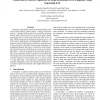Free Online Productivity Tools
i2Speak
i2Symbol
i2OCR
iTex2Img
iWeb2Print
iWeb2Shot
i2Type
iPdf2Split
iPdf2Merge
i2Bopomofo
i2Arabic
i2Style
i2Image
i2PDF
iLatex2Rtf
Sci2ools
ASPDAC
2006
ACM
2006
ACM
Generation of shorter sequences for high resolution error diagnosis using sequential SAT
Commonly used pattern sources in simulation-based verification include random, guided random, or design verification patterns. Although these patterns may help bring the design to those hard-to-reach states for activating the errors and for propagating them to observation points, they tend to be very long, which complicates the subsequent diagnosis process. As a key step in reducing the overall diagnosis complexity, we propose a method of generating a shorter error-sequence based on a given long error-sequence. We formulate the problem as a satisfiability problem and employ a SAT solver as the underlying engine for this task. By heuristically selecting an intermediate state Si which is reachable by the given long sequence, the task of finding the transfer sequence from the initial state to the target state can be divided into two easier tasks - finding a transfer sequence from the initial state to Si and one from Si to the target state. Our preliminary experimental results on pub...
| Added | 13 Jun 2010 |
| Updated | 13 Jun 2010 |
| Type | Conference |
| Year | 2006 |
| Where | ASPDAC |
| Authors | Sung-Jui (Song-Ra) Pan, Kwang-Ting Cheng, John Moondanos, Ziyad Hanna |
Comments (0)

